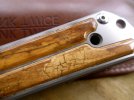More than you may want to know but answers your question. (from Boone)
Fossil ivory comes from three sources—it is either walrus ivory that has been buried for hundreds to thousands of years or it is 10,000-plus-year-old ivory from the long extinct woolly mammoth or mastodon. All of these ivories have been buried for centuries and have absorbed minerals from the soil that have turned them varying colors from tan, orange, golden brown, and chocolate brown to even black; occasionally a blue or green color is also seen. This ivory is not truly fossilized in the sense that the ivory has been replaced with minerals/stone; it is really just beginning to become mineralized. It is in the earliest stages of fossilization and is just slightly harder than fresh ivory. "Fossil" ivory can be cut or worked with the same tools that regular ivory is worked with as listed below, the only difference you may notice is that due to the minerals it generally has a rather unpleasant smell when it is being sawn or sanded and it takes an even better shine than fresh ivory. Most "fossil" walrus ivory is found in the form of Eskimo artifacts, usually sled runners, large chopping tools (adzes or mauls) or net weights; this is because the Eskimo had lots of ivory and very little good wood. The Eskimo dig for these artifacts during the warm summer months at ancient village sites.












